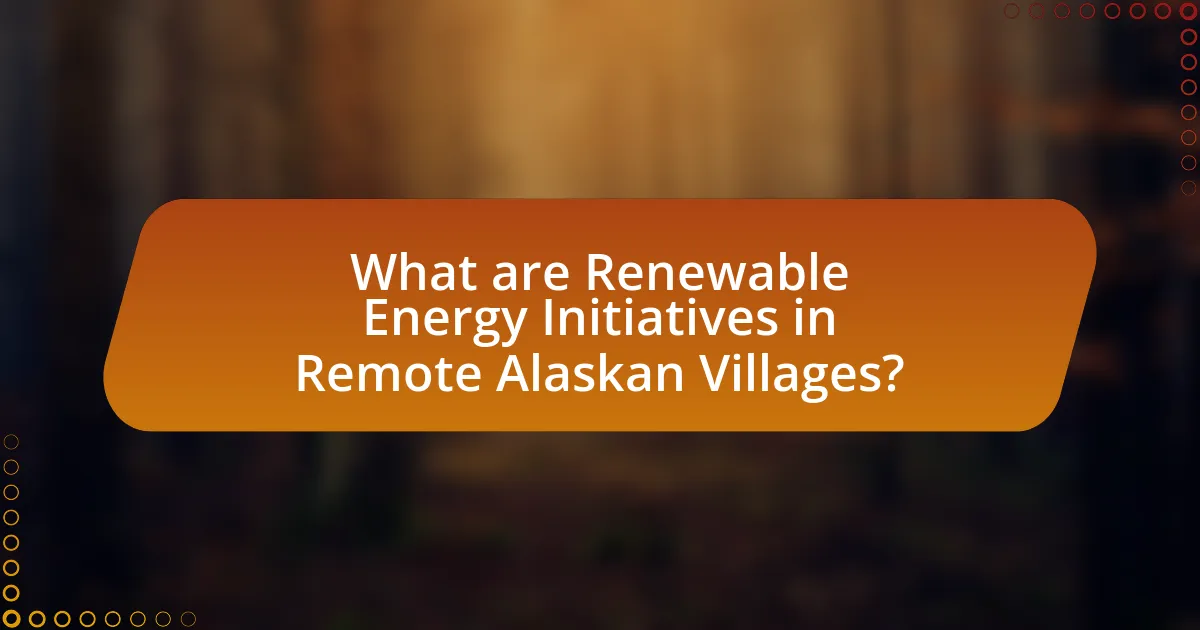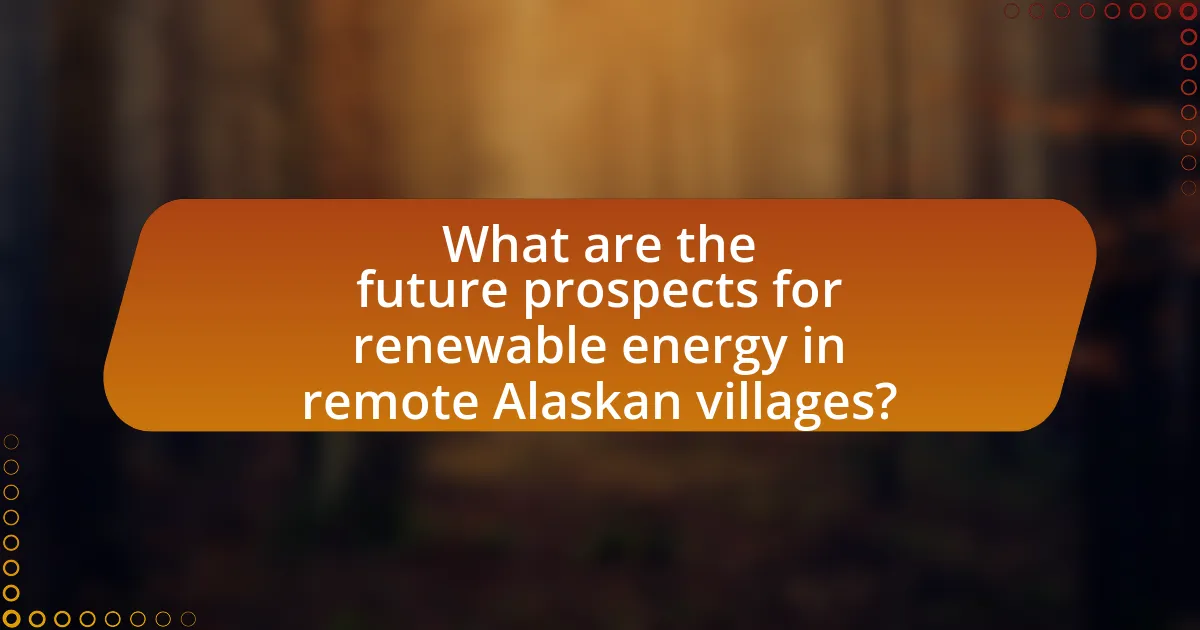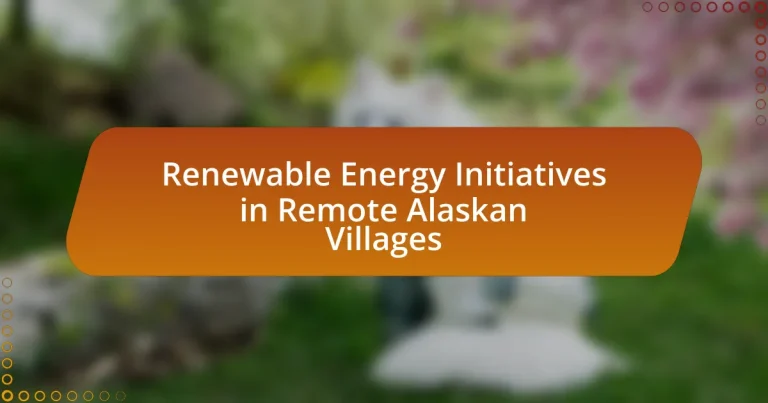Renewable energy initiatives in remote Alaskan villages focus on utilizing local resources such as wind, solar, and hydroelectric power to decrease dependence on costly diesel fuel. These initiatives, exemplified by projects in villages like Kotzebue and Shaktoolik, aim to enhance energy independence, reduce emissions, and lower energy costs, which can consume a significant portion of community budgets. Challenges such as high initial costs, logistical issues, and limited technical expertise hinder implementation, but local community involvement and partnerships with organizations like the Alaska Energy Authority are crucial for success. The article explores the types of renewable energy sources being utilized, the social and economic benefits they provide, and the future prospects for sustainable energy solutions in these isolated communities.

What are Renewable Energy Initiatives in Remote Alaskan Villages?
Renewable energy initiatives in remote Alaskan villages primarily focus on harnessing local resources such as wind, solar, and hydroelectric power to reduce reliance on diesel fuel. For instance, the village of Kotzebue has implemented a wind-diesel hybrid system that generates approximately 60% of its electricity from wind energy, significantly lowering fuel costs and emissions. Additionally, the Alaska Energy Authority has supported projects like the installation of solar panels in villages such as Shaktoolik, which has increased energy independence and sustainability. These initiatives are crucial for enhancing energy security and addressing the high costs of energy in remote areas.
How do these initiatives address energy needs in remote areas?
Renewable energy initiatives in remote Alaskan villages address energy needs by providing sustainable and reliable energy sources, reducing dependence on costly fossil fuels. These initiatives often involve the installation of solar panels, wind turbines, and micro-hydro systems, which harness local natural resources to generate electricity. For instance, the Alaska Energy Authority reported that projects like the Igiugig Village’s micro-hydro system have significantly lowered energy costs and increased energy independence, demonstrating the effectiveness of renewable solutions in these isolated communities.
What specific energy challenges do these villages face?
Remote Alaskan villages face significant energy challenges, primarily due to their geographic isolation and reliance on expensive diesel fuel for electricity generation. These villages often experience high energy costs, with some communities spending up to 50% of their annual budgets on fuel. Additionally, the harsh climate and limited infrastructure hinder the development and maintenance of renewable energy systems, making it difficult to transition to more sustainable energy sources. The lack of consistent funding and technical expertise further complicates efforts to implement renewable energy initiatives, leaving many villages vulnerable to energy shortages and price fluctuations.
How do renewable energy sources provide solutions to these challenges?
Renewable energy sources provide solutions to the challenges faced by remote Alaskan villages by offering sustainable and reliable alternatives to fossil fuels. These sources, such as wind, solar, and hydroelectric power, reduce dependence on expensive and often unreliable fuel shipments, which can be disrupted by harsh weather conditions. For instance, a study by the Alaska Center for Energy and Power found that integrating renewable energy systems can lower energy costs by up to 50% in isolated communities. Additionally, renewable energy enhances energy security and resilience, as it allows villages to generate power locally, mitigating the risks associated with fuel supply chains.
Why are renewable energy initiatives important for these communities?
Renewable energy initiatives are crucial for remote Alaskan villages because they provide sustainable energy solutions that reduce reliance on expensive fossil fuels. These communities often face high energy costs and limited access to traditional energy sources, making renewable options like wind, solar, and hydroelectric power economically viable alternatives. For instance, a study by the Alaska Energy Authority found that transitioning to renewable energy can lower energy costs by up to 50% in some villages, enhancing economic stability and resilience. Additionally, renewable energy initiatives contribute to environmental sustainability by decreasing greenhouse gas emissions, which is vital for preserving the fragile Arctic ecosystem.
What social and economic benefits do they provide?
Renewable energy initiatives in remote Alaskan villages provide significant social and economic benefits, including reduced energy costs and enhanced community resilience. By utilizing local renewable resources such as wind and solar, these initiatives lower dependence on expensive imported fossil fuels, which can account for up to 80% of energy costs in some villages. Additionally, the implementation of renewable energy systems fosters job creation within the community, as local residents are often trained to install and maintain these technologies. This not only stimulates the local economy but also empowers residents by providing them with valuable skills. Furthermore, renewable energy projects contribute to environmental sustainability, which is crucial for the preservation of the natural resources that these communities rely on for their livelihoods.
How do they contribute to environmental sustainability?
Renewable energy initiatives in remote Alaskan villages contribute to environmental sustainability by reducing reliance on fossil fuels and minimizing greenhouse gas emissions. These initiatives, such as solar, wind, and hydroelectric power projects, harness local renewable resources, which decreases carbon footprints and promotes cleaner air quality. For instance, a study by the U.S. Department of Energy found that transitioning to renewable energy sources can reduce emissions by up to 80% in isolated communities. Additionally, these initiatives enhance energy independence, allowing villages to utilize local resources sustainably while preserving the natural environment.
What types of renewable energy sources are being utilized?
The types of renewable energy sources being utilized in remote Alaskan villages include wind energy, solar energy, and hydroelectric power. Wind energy is harnessed through turbines, which can generate electricity even in low-wind conditions, making it suitable for the region’s climate. Solar energy is captured using photovoltaic panels, which are increasingly effective due to advancements in technology, despite the limited sunlight during winter months. Hydroelectric power is generated from local water sources, providing a consistent and reliable energy supply. These renewable sources are essential for reducing reliance on diesel fuel, which is costly and environmentally damaging.
How is solar energy being implemented in these villages?
Solar energy is being implemented in remote Alaskan villages through the installation of photovoltaic systems that convert sunlight into electricity. These systems are often integrated into existing energy infrastructures to provide a reliable power source, especially during the long winter months when traditional energy sources may be less effective. For instance, the Alaska Energy Authority has supported projects that deploy solar panels alongside battery storage systems, enabling communities to harness solar power effectively and reduce reliance on diesel generators. This approach not only lowers energy costs but also contributes to sustainability efforts by decreasing carbon emissions associated with fossil fuel use.
What role does wind energy play in local energy systems?
Wind energy plays a crucial role in local energy systems by providing a sustainable and renewable source of electricity, particularly in remote Alaskan villages where traditional energy sources are limited. In these areas, wind energy can significantly reduce reliance on imported fossil fuels, thereby lowering energy costs and enhancing energy security. For instance, the Alaska Energy Authority reported that integrating wind energy into local grids can lead to a reduction in diesel fuel consumption by up to 50%, demonstrating its effectiveness in improving local energy resilience and sustainability.
Are there any geothermal or hydroelectric projects in these areas?
Yes, there are geothermal and hydroelectric projects in remote Alaskan villages. For instance, the village of Akutan has a geothermal project that utilizes the region’s volcanic activity to generate energy. Additionally, the village of Igiugig has implemented a hydroelectric project that harnesses the Kvichak River to produce renewable electricity. These initiatives are part of broader efforts to enhance energy sustainability in remote areas of Alaska, reducing reliance on diesel fuel and promoting cleaner energy sources.
What are the key challenges faced in implementing these initiatives?
The key challenges faced in implementing renewable energy initiatives in remote Alaskan villages include high initial costs, logistical difficulties, and limited technical expertise. High initial costs arise from the need for specialized equipment and infrastructure, which can be financially burdensome for small communities. Logistical difficulties stem from the remote locations of these villages, making transportation of materials and maintenance of systems complex and expensive. Limited technical expertise is a significant barrier, as many villages lack the necessary skilled personnel to install and maintain renewable energy systems effectively. These challenges hinder the successful deployment and sustainability of renewable energy projects in these areas.
How do logistical issues affect project development?
Logistical issues significantly hinder project development by causing delays, increasing costs, and complicating resource allocation. In the context of renewable energy initiatives in remote Alaskan villages, challenges such as transportation difficulties, limited access to materials, and inadequate infrastructure can impede timely project execution. For instance, the remoteness of these villages often results in higher shipping costs and longer lead times for essential equipment, which can delay the installation of renewable energy systems. Additionally, the lack of local skilled labor can necessitate bringing in external workers, further complicating logistics and increasing project expenses. These factors collectively contribute to the overall inefficiency and potential failure of renewable energy projects in these areas.
What financial barriers exist for renewable energy projects?
Financial barriers for renewable energy projects include high initial capital costs, limited access to financing, and uncertain revenue streams. High initial capital costs can deter investment, as renewable energy technologies often require significant upfront expenditures. Limited access to financing is prevalent in remote areas, where traditional financial institutions may be reluctant to invest due to perceived risks. Additionally, uncertain revenue streams arise from fluctuating energy prices and regulatory changes, making it difficult for projects to secure long-term funding. These factors collectively hinder the development and implementation of renewable energy initiatives in remote Alaskan villages.

How are local communities involved in renewable energy initiatives?
Local communities in remote Alaskan villages are actively involved in renewable energy initiatives by participating in project planning, implementation, and management. These communities often collaborate with organizations and government agencies to identify local energy needs and develop tailored renewable energy solutions, such as wind, solar, and hydroelectric systems. For instance, the Alaska Energy Authority has supported community-driven projects that empower residents to take ownership of energy resources, leading to increased energy independence and sustainability. Additionally, local involvement ensures that renewable energy initiatives align with cultural values and environmental considerations specific to the region, enhancing community support and project success.
What role do community members play in project planning and execution?
Community members play a crucial role in project planning and execution for renewable energy initiatives in remote Alaskan villages by providing local knowledge, ensuring cultural relevance, and fostering community buy-in. Their involvement helps identify specific energy needs and preferences, which leads to more effective and sustainable solutions. For instance, community input can guide the selection of appropriate technologies, such as solar or wind energy systems, that align with local environmental conditions and cultural practices. Research indicates that projects with strong community engagement are 30% more likely to succeed, as evidenced by the success of the Kivalina Wind Project, which incorporated extensive community feedback during its planning stages.
How does local knowledge contribute to the success of these initiatives?
Local knowledge significantly enhances the success of renewable energy initiatives in remote Alaskan villages by ensuring that projects are tailored to the specific environmental, cultural, and social contexts of the communities. This localized understanding allows for the identification of suitable renewable energy sources, such as wind or solar, that align with the region’s climate and geography. For instance, local residents can provide insights into seasonal weather patterns that affect energy generation, which is crucial for optimizing system performance. Additionally, incorporating local knowledge fosters community buy-in and participation, as residents feel a sense of ownership over the initiatives, leading to higher engagement and maintenance of the systems. Studies have shown that projects that integrate local input are more likely to succeed; for example, the Alaska Energy Authority reported that community-driven renewable projects have a 30% higher success rate compared to those designed without local involvement.
What training programs are available for community members?
Training programs available for community members in remote Alaskan villages focus on renewable energy technologies, including solar panel installation, wind turbine maintenance, and energy efficiency practices. These programs are often facilitated by local organizations and partnerships with educational institutions, aiming to empower residents with skills necessary for sustainable energy solutions. For instance, the Alaska Center for Energy and Power offers workshops and hands-on training sessions that equip participants with practical knowledge and technical skills relevant to renewable energy systems.
How do partnerships with external organizations enhance these initiatives?
Partnerships with external organizations enhance renewable energy initiatives in remote Alaskan villages by providing access to funding, expertise, and technology. These collaborations often involve governmental agencies, non-profits, and private companies that bring resources and knowledge essential for the successful implementation of renewable energy projects. For instance, partnerships with organizations like the Alaska Energy Authority have facilitated the development of wind and solar energy systems, which are crucial for reducing reliance on diesel fuel. Additionally, external organizations can offer training and capacity-building programs, ensuring that local communities are equipped to maintain and operate renewable energy systems effectively. This multifaceted support not only accelerates project development but also fosters sustainable energy practices within these remote communities.
What types of organizations are typically involved?
Organizations typically involved in renewable energy initiatives in remote Alaskan villages include non-profit organizations, government agencies, and private sector companies. Non-profit organizations often focus on community engagement and education, while government agencies provide funding and regulatory support. Private sector companies contribute technology and expertise in renewable energy solutions. For example, the Alaska Energy Authority collaborates with local communities to implement renewable energy projects, demonstrating the active participation of these types of organizations in advancing sustainable energy solutions in remote areas.
How do these partnerships impact funding and resources?
Partnerships in renewable energy initiatives in remote Alaskan villages significantly enhance funding and resources by pooling financial contributions and expertise from multiple stakeholders. These collaborations often involve local governments, non-profit organizations, and private companies, which collectively increase the available capital for projects. For instance, the partnership between the Alaska Energy Authority and various federal agencies has led to millions in grants and low-interest loans specifically aimed at renewable energy development. This collaborative approach not only secures necessary funding but also facilitates access to advanced technologies and best practices, ultimately improving the sustainability and efficiency of energy solutions in these communities.

What are the future prospects for renewable energy in remote Alaskan villages?
The future prospects for renewable energy in remote Alaskan villages are promising, driven by advancements in technology and increasing investments. These villages face high energy costs and reliance on diesel fuel, prompting a shift towards renewable sources such as wind, solar, and hydroelectric power. For instance, the Alaska Energy Authority has reported that several villages are successfully integrating solar panels and wind turbines, which can significantly reduce energy expenses and enhance energy independence. Additionally, federal and state initiatives are providing funding and support for renewable energy projects, further solidifying the potential for sustainable energy solutions in these communities.
How can technology advancements improve renewable energy initiatives?
Technology advancements can significantly improve renewable energy initiatives by enhancing efficiency, reducing costs, and increasing accessibility. For instance, innovations in solar panel technology, such as bifacial panels, can capture more sunlight and generate up to 27% more energy compared to traditional panels. Additionally, advancements in energy storage solutions, like lithium-ion batteries, allow for better management of energy supply and demand, ensuring a reliable power source even in remote locations. Furthermore, smart grid technologies enable real-time monitoring and optimization of energy distribution, which is crucial for isolated communities in Alaska. These improvements not only make renewable energy more viable but also support sustainability and energy independence in remote Alaskan villages.
What innovations are currently being explored in the field?
Innovations currently being explored in the field of renewable energy initiatives in remote Alaskan villages include the integration of microgrid systems, advanced energy storage solutions, and the use of hybrid renewable energy systems combining solar, wind, and biomass. Microgrid systems enable villages to generate and manage their own energy independently, enhancing resilience and reducing reliance on diesel fuel. Advanced energy storage technologies, such as lithium-ion batteries and flow batteries, are being tested to store excess energy generated during peak production times for use during low production periods. Hybrid systems are being developed to optimize energy generation and consumption, ensuring a more reliable and sustainable energy supply. These innovations are supported by research from organizations like the U.S. Department of Energy, which highlights the potential for these technologies to significantly improve energy access and sustainability in remote areas.
How might these innovations affect energy accessibility?
Innovations in renewable energy initiatives in remote Alaskan villages significantly enhance energy accessibility by providing sustainable and reliable power sources. These initiatives, such as solar panels and wind turbines, reduce dependence on costly and environmentally harmful fossil fuels, which are often difficult to transport to isolated areas. For instance, a study by the Alaska Center for Energy and Power found that integrating renewable energy systems can lower energy costs by up to 50% in remote communities. This increased accessibility not only improves the quality of life for residents but also fosters economic development by enabling local businesses to operate more efficiently.
What best practices can be adopted for successful implementation?
Successful implementation of renewable energy initiatives in remote Alaskan villages can be achieved by engaging local communities, ensuring cultural sensitivity, and securing sustainable funding. Engaging local communities fosters ownership and support, which is crucial for long-term success; studies show that projects with community involvement have a higher success rate. Cultural sensitivity ensures that the initiatives align with the values and practices of the local population, which can enhance acceptance and participation. Securing sustainable funding is essential for maintaining operations and scaling projects; for instance, leveraging state and federal grants has proven effective in similar initiatives across rural areas.
How can communities ensure sustainability of renewable energy projects?
Communities can ensure the sustainability of renewable energy projects by actively engaging in local governance, securing funding, and fostering education and awareness. Local governance allows communities to make decisions that reflect their unique needs and priorities, which is essential for the long-term success of renewable initiatives. Securing funding through grants, partnerships, and community investments provides the necessary financial resources to maintain and expand these projects. Education and awareness programs empower residents with knowledge about renewable energy benefits and operational practices, which can lead to increased community support and participation. For instance, a study by the Alaska Center for Energy and Power highlights that communities that prioritize local involvement and education see higher rates of project success and sustainability.
What lessons have been learned from past initiatives?
Past initiatives in renewable energy in remote Alaskan villages have demonstrated the importance of community involvement and tailored solutions. Engaging local populations ensures that projects meet specific needs and gain community support, which is crucial for sustainability. For instance, the Kivalina Wind Project highlighted that integrating local knowledge and preferences led to better acceptance and operational success. Additionally, these initiatives revealed the necessity of reliable funding and technical support, as seen in the experience of the village of Shishmaref, where inconsistent funding hampered project implementation. Overall, successful renewable energy projects in these regions require a collaborative approach, adequate resources, and adaptability to local conditions.
What resources are available for communities interested in renewable energy?
Communities interested in renewable energy can access various resources, including government grants, technical assistance programs, and educational materials. The U.S. Department of Energy offers funding opportunities through initiatives like the Solar Energy Technologies Office and the Wind Energy Technologies Office, which support local projects. Additionally, organizations such as the Renewable Energy Alaska Project provide technical support and resources tailored to Alaskan communities, helping them implement renewable energy solutions. These resources are crucial for facilitating the transition to sustainable energy sources in remote areas.
How can villages access funding and grants for renewable projects?
Villages can access funding and grants for renewable projects through various federal and state programs specifically designed to support renewable energy initiatives. For instance, the U.S. Department of Agriculture offers the Rural Energy for America Program, which provides grants and loan guarantees for renewable energy systems. Additionally, the Department of Energy has programs like the Tribal Energy Program that assist Native American communities in developing renewable energy projects. These programs often require villages to submit proposals outlining their project plans, expected benefits, and community involvement. Furthermore, local and regional organizations may also provide funding opportunities tailored to specific renewable energy initiatives, enhancing the financial resources available to villages.
What organizations provide support and guidance for implementation?
Organizations that provide support and guidance for implementation of renewable energy initiatives in remote Alaskan villages include the Alaska Energy Authority, the U.S. Department of Energy, and the Renewable Energy Alaska Project. The Alaska Energy Authority offers technical assistance and funding for energy projects, while the U.S. Department of Energy provides resources and research support for renewable energy technologies. The Renewable Energy Alaska Project focuses on promoting renewable energy solutions and offers guidance on project development and implementation. These organizations play a crucial role in facilitating the transition to sustainable energy sources in remote areas.


